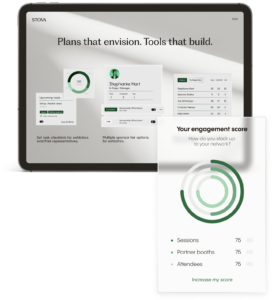Tracking Networking ROI: Measuring In-person Event Impact
May 16, 2024
Measuring networking in a virtual event is easy. Everything happens through a digital platform where every interaction is trackable, at least statistically. Measuring networking is less straightforward at an in-person event – but it doesn’t have to be. Here’s how.

Unlike virtual events where every interaction is easily trackable, the intangible nature of face-to-face networking poses a unique challenge when it comes to measuring success.
How do you know whether people connected effectively at the event? How can you gauge the quality of those connections?
In many cases, answering these questions is an informal process of putting onsite attendees on the spot and canvassing their opinions. The result is a subjective impression based on mostly anecdotal evidence.
As the industry evolves and accountability around performance increases, event professionals will need to learn and develop robust systems for demonstrating the networking value of their events to their stakeholders.
This article will cover designing networking experiences that you can measure and strategies for tracking networking success.
Networking ROI Starts at Inception
The impact of an event’s networking may only be fully realized over extended periods of time. It can be especially complicated to attribute improvements in larger organizational functions like, for example, sales outreach or closed-won deals to a single factor like an event.
However, it can be useful to define key performance indicators (KPIs) and metrics for success at the outset based on the type of event and what you’re hoping to achieve. This will give you a basis for defining success on your own terms even if the real extended impact might be harder to discern. The KPIs you define needn’t be the last word on the subject; figuring them out is usually an iterative process, but it’s the first step to going beyond merely anecdotal “people seemed to like it” reporting.
Let’s consider a sales meeting for which the networking objectives might include improving team cohesion and overall motivation.
What sort of networking activity might give you that kind of data?
A gamified experience in which sales personnel work together to compete for prizes, prestige, and a position on a leaderboard can supply data on how disposed team members are to engage and how well they work together to achieve business objectives.
Getting a grasp on the data you need can also inform the way you execute these activities. Selecting a tech partner that allows you to track different elements of the game will give you a choice of metrics to consider when you’re evaluating its success. A mobile app that allows you to track the number of participants, the number of check-ins at different stations, or the number of points each person accrues will provide you with a series of direct indicators for engagement and motivation. Quizzes or polls within the app can help you test for content retention, and approval prompts at regular checkpoints or after specified achievements can give you sentiment data and help to evaluate satisfaction with the experience.
While these data points alone likely won’t give you a total roadmap to your networking ROI, they can shed light on an event’s success in the moment and the role it played in the larger objectives down the line.
Tech that Supports a Direct Analysis
As alluded to above, your event technology will be a major factor in your ability to attach real quantitative data to your in-person networking success.
Mobile App Tracking
Mobile event apps often include features like in-app messaging, attendee profiles, and appointment scheduling, all of which generate valuable data on interactions between attendees. Analyzing these metrics can provide a baseline minimum for an event’s networking activity and its outcomes.
Stova can help to improve app-facilitated networking through smart connection recommendations that bring attendees with compatible interests and objectives together.
Meeting Tracking
Many event technology solutions allow attendees and other stakeholders to schedule one-on-one meetings ahead of time or in the moment, which is one indication of the event’s volume of connections. Whether it’s through a designated meeting area equipped with RFID technology or through the event app where attendees can schedule meetings, tracking these interactions provides concrete data on networking effectiveness. They can also help you to uncover patterns in meeting frequency and duration to identify successful networking connections.
Lead Generation Tracking
For events where lead generation is a key objective, tracking leads generated through networking interactions is crucial. Organizers will typically supply systems to capture leads exchanged during the event, whether it’s through business card scans, QR code exchanges, or ideally digital lead capture apps like Stova Digital Lead Capture that integrate with customer relationship management tools. By correlating these leads with networking activities, you can quantify the ROI of networking efforts in terms of potential business opportunities.
Networking Session Ratings
Mobile technology also offers options for gathering feedback from attendees about their networking experiences. Through post-session surveys or ratings, organizers can ask participants to rate the quality of networking sessions, the relevance of connections made, and their overall satisfaction with the experience. A survey alternative that can result in improved response rates is to simply deliver a thumbs-up / thumbs-down binary approval prompt after a networking experience.
Analyzing these ratings provides valuable insights into areas for improvement and can contribute qualitative data to the quantitative data you’re collecting.
Deductive Analysis: Educated Guesses About Networking ROI
While technology can certainly provide direct indicators, the long-term ROI of an event’s networking may require a little more sleuthing. This is where a deductive analysis comes in. There are a number of indicators that you can use to contextualize the rest of your data and to make educated guesses about how well your networking performed. Here are some examples.
Attendance Tracking
One of the simplest ways to gauge networking effectiveness is through attendance tracking. While it doesn’t capture the quality of interactions, it does give insight into the level of interest attendees have in networking opportunities. By comparing attendance numbers for networking sessions against overall event attendance, you can assess the popularity of the networking activities you planned.
Post-event Signals of Positive Networking ROI
Post-event indicators that signal successful networking could include an uptick in team communication, improved participation in collaborative projects, increased interdepartmental knowledge sharing, or general improvements in retention / reductions in team churn.
In order to better establish networking’s role in motivating these outcomes, follow-up and solicit feedback after the fact as well. Try allotting time within the workday to fill out a general and anonymous feedback survey, and include questions about the event’s networking experience. This will let you know if it has left a lasting effect on your event stakeholders’ memory.
Social Media Mentions
Increased engagement on social media platforms related to the event, such as a surge in event-related hashtags or a spike in LinkedIn connections among stakeholders, can shed light on the success of your networking efforts. Monitor platforms like Twitter, LinkedIn, and Instagram for posts about connections made or valuable conversations had during the event. Analyzing the sentiment and reach of these posts can help quantify the impact of networking activities.
Digital events get all the credit for networking trackability. However, with a little elbow grease, you can determine if and how networking at in-person events is performing, and change the formerly intangible into something you can begin to hang your event ROI on.
Whether your event is virtual, hybrid, or in-person, enhance your attendee’s journey with an event ecosystem built for your audience. Ready to walk through Stova's event technology solutions? Schedule some time with us today.


